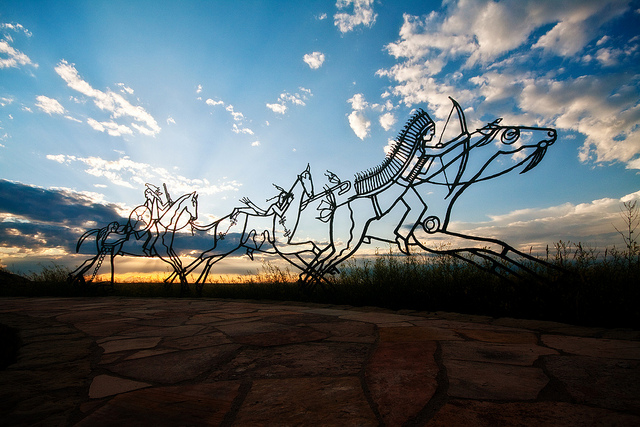
Sculpture at the Indian Memorial at Little Bighorn by Oglala Sioux artist Colleen Cutschall. Photo © Nomadic Lass, licensed Creative Commons Attribution Share-alike.
The culture and lives of indigenous people have powerfully defined the identities of both Montana and Wyoming. Both states offer tremendous opportunities for those interested in learning about and experiencing Native American history, traditions, and contemporary life.
Led by Blackfeet tribe member, historian, and well-known artist Darryl Norman, Blackfeet Cultural History Tours offers step-on guided trips of the Blackfeet Reservation. Darryl takes guests to buffalo jumps, tipi rings, and medicine lodges. Tours often include visits to the Museum of the Plains Indian.
This moving historic site bears witness to the battle between Chief Joseph’s band of Nez Perce and the U.S. Army.
Little Bighorn Battlefield National Monument is where thousands of Cheyenne, Sioux, and Arapaho warriors fought under such legendary figures as Sitting Bull and Crazy Horse. Lieutenant Colonel George Armstrong Custer and more than 200 men from his 7th Cavalry died in the brief battle.
Held the third week in August every year since 1904, Crow Fair is considered the largest outdoor powwow in the world. More than 12,000 people camp out in more than 1,500 tipis erected on the banks of the Little Bighorn River.
This mysterious carved stone wheel has spiritual but unexplained significance to many Native American tribes. Interpretive tours are offered by local Native American guides.
This iconic rocky sentinel, the first national monument in the country, is considered sacred by numerous tribes, all of whom have unique origin stories for it. A voluntary climbing closure is in effect each June out of respect for various Native American ceremonies.
Wyoming’s only reservation is home to about 5,000 Northern Arapaho and some 2,500 Eastern Shoshone Indians. Sights of interest include the Shoshone Tribal Cultural Center and the grave sites of the two most prominent Shoshone Indians, Chief Washakie and Lewis and Clark’s guide, Sacagawea.
The best time to visit is during the annual three-day powwows. The largest Shoshone powwow is the Eastern Shoshone Indian Days Powwow and Rodeo, held the fourth weekend in June. The largest Arapaho powwow is the Ethete Powwow in late July.
Excerpted from the Second Edition of Moon Montana & Wyoming.